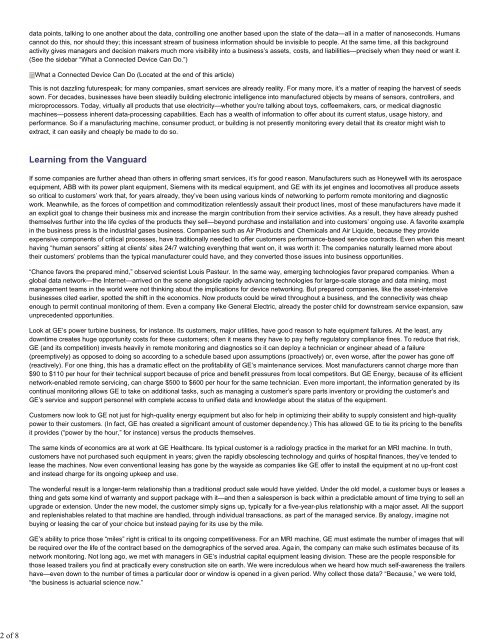Four Strategies for the Age of Smart Services - Courses
Four Strategies for the Age of Smart Services - Courses
Four Strategies for the Age of Smart Services - Courses
You also want an ePaper? Increase the reach of your titles
YUMPU automatically turns print PDFs into web optimized ePapers that Google loves.
2 <strong>of</strong> 8<br />
data points, talking to one ano<strong>the</strong>r about <strong>the</strong> data, controlling one ano<strong>the</strong>r based upon <strong>the</strong> state <strong>of</strong> <strong>the</strong> data—all in a matter <strong>of</strong> nanoseconds. Humans<br />
cannot do this, nor should <strong>the</strong>y; this incessant stream <strong>of</strong> business in<strong>for</strong>mation should be invisible to people. At <strong>the</strong> same time, all this background<br />
activity gives managers and decision makers much more visibility into a business’s assets, costs, and liabilities—precisely when <strong>the</strong>y need or want it.<br />
(See <strong>the</strong> sidebar “What a Connected Device Can Do.”)<br />
What a Connected Device Can Do (Located at <strong>the</strong> end <strong>of</strong> this article)<br />
This is not dazzling futurespeak; <strong>for</strong> many companies, smart services are already reality. For many more, it’s a matter <strong>of</strong> reaping <strong>the</strong> harvest <strong>of</strong> seeds<br />
sown. For decades, businesses have been steadily building electronic intelligence into manufactured objects by means <strong>of</strong> sensors, controllers, and<br />
microprocessors. Today, virtually all products that use electricity—whe<strong>the</strong>r you’re talking about toys, c<strong>of</strong>feemakers, cars, or medical diagnostic<br />
machines—possess inherent data-processing capabilities. Each has a wealth <strong>of</strong> in<strong>for</strong>mation to <strong>of</strong>fer about its current status, usage history, and<br />
per<strong>for</strong>mance. So if a manufacturing machine, consumer product, or building is not presently monitoring every detail that its creator might wish to<br />
extract, it can easily and cheaply be made to do so.<br />
Learning from <strong>the</strong> Vanguard<br />
If some companies are fur<strong>the</strong>r ahead than o<strong>the</strong>rs in <strong>of</strong>fering smart services, it’s <strong>for</strong> good reason. Manufacturers such as Honeywell with its aerospace<br />
equipment, ABB with its power plant equipment, Siemens with its medical equipment, and GE with its jet engines and locomotives all produce assets<br />
so critical to customers’ work that, <strong>for</strong> years already, <strong>the</strong>y’ve been using various kinds <strong>of</strong> networking to per<strong>for</strong>m remote monitoring and diagnostic<br />
work. Meanwhile, as <strong>the</strong> <strong>for</strong>ces <strong>of</strong> competition and commoditization relentlessly assault <strong>the</strong>ir product lines, most <strong>of</strong> <strong>the</strong>se manufacturers have made it<br />
an explicit goal to change <strong>the</strong>ir business mix and increase <strong>the</strong> margin contribution from <strong>the</strong>ir service activities. As a result, <strong>the</strong>y have already pushed<br />
<strong>the</strong>mselves fur<strong>the</strong>r into <strong>the</strong> life cycles <strong>of</strong> <strong>the</strong> products <strong>the</strong>y sell—beyond purchase and installation and into customers’ ongoing use. A favorite example<br />
in <strong>the</strong> business press is <strong>the</strong> industrial gases business. Companies such as Air Products and Chemicals and Air Liquide, because <strong>the</strong>y provide<br />
expensive components <strong>of</strong> critical processes, have traditionally needed to <strong>of</strong>fer customers per<strong>for</strong>mance-based service contracts. Even when this meant<br />
having “human sensors” sitting at clients’ sites 24/7 watching everything that went on, it was worth it: The companies naturally learned more about<br />
<strong>the</strong>ir customers’ problems than <strong>the</strong> typical manufacturer could have, and <strong>the</strong>y converted those issues into business opportunities.<br />
“Chance favors <strong>the</strong> prepared mind,” observed scientist Louis Pasteur. In <strong>the</strong> same way, emerging technologies favor prepared companies. When a<br />
global data network—<strong>the</strong> Internet—arrived on <strong>the</strong> scene alongside rapidly advancing technologies <strong>for</strong> large-scale storage and data mining, most<br />
management teams in <strong>the</strong> world were not thinking about <strong>the</strong> implications <strong>for</strong> device networking. But prepared companies, like <strong>the</strong> asset-intensive<br />
businesses cited earlier, spotted <strong>the</strong> shift in <strong>the</strong> economics. Now products could be wired throughout a business, and <strong>the</strong> connectivity was cheap<br />
enough to permit continual monitoring <strong>of</strong> <strong>the</strong>m. Even a company like General Electric, already <strong>the</strong> poster child <strong>for</strong> downstream service expansion, saw<br />
unprecedented opportunities.<br />
Look at GE’s power turbine business, <strong>for</strong> instance. Its customers, major utilities, have good reason to hate equipment failures. At <strong>the</strong> least, any<br />
downtime creates huge opportunity costs <strong>for</strong> <strong>the</strong>se customers; <strong>of</strong>ten it means <strong>the</strong>y have to pay hefty regulatory compliance fines. To reduce that risk,<br />
GE (and its competition) invests heavily in remote monitoring and diagnostics so it can deploy a technician or engineer ahead <strong>of</strong> a failure<br />
(preemptively) as opposed to doing so according to a schedule based upon assumptions (proactively) or, even worse, after <strong>the</strong> power has gone <strong>of</strong>f<br />
(reactively). For one thing, this has a dramatic effect on <strong>the</strong> pr<strong>of</strong>itability <strong>of</strong> GE’s maintenance services. Most manufacturers cannot charge more than<br />
$90 to $110 per hour <strong>for</strong> <strong>the</strong>ir technical support because <strong>of</strong> price and benefit pressures from local competitors. But GE Energy, because <strong>of</strong> its efficient<br />
network-enabled remote servicing, can charge $500 to $600 per hour <strong>for</strong> <strong>the</strong> same technician. Even more important, <strong>the</strong> in<strong>for</strong>mation generated by its<br />
continual monitoring allows GE to take on additional tasks, such as managing a customer’s spare parts inventory or providing <strong>the</strong> customer’s and<br />
GE’s service and support personnel with complete access to unified data and knowledge about <strong>the</strong> status <strong>of</strong> <strong>the</strong> equipment.<br />
Customers now look to GE not just <strong>for</strong> high-quality energy equipment but also <strong>for</strong> help in optimizing <strong>the</strong>ir ability to supply consistent and high-quality<br />
power to <strong>the</strong>ir customers. (In fact, GE has created a significant amount <strong>of</strong> customer dependency.) This has allowed GE to tie its pricing to <strong>the</strong> benefits<br />
it provides (“power by <strong>the</strong> hour,” <strong>for</strong> instance) versus <strong>the</strong> products <strong>the</strong>mselves.<br />
The same kinds <strong>of</strong> economics are at work at GE Healthcare. Its typical customer is a radiology practice in <strong>the</strong> market <strong>for</strong> an MRI machine. In truth,<br />
customers have not purchased such equipment in years; given <strong>the</strong> rapidly obsolescing technology and quirks <strong>of</strong> hospital finances, <strong>the</strong>y’ve tended to<br />
lease <strong>the</strong> machines. Now even conventional leasing has gone by <strong>the</strong> wayside as companies like GE <strong>of</strong>fer to install <strong>the</strong> equipment at no up-front cost<br />
and instead charge <strong>for</strong> its ongoing upkeep and use.<br />
The wonderful result is a longer-term relationship than a traditional product sale would have yielded. Under <strong>the</strong> old model, a customer buys or leases a<br />
thing and gets some kind <strong>of</strong> warranty and support package with it—and <strong>the</strong>n a salesperson is back within a predictable amount <strong>of</strong> time trying to sell an<br />
upgrade or extension. Under <strong>the</strong> new model, <strong>the</strong> customer simply signs up, typically <strong>for</strong> a five-year-plus relationship with a major asset. All <strong>the</strong> support<br />
and replenishables related to that machine are handled, through individual transactions, as part <strong>of</strong> <strong>the</strong> managed service. By analogy, imagine not<br />
buying or leasing <strong>the</strong> car <strong>of</strong> your choice but instead paying <strong>for</strong> its use by <strong>the</strong> mile.<br />
GE’s ability to price those “miles” right is critical to its ongoing competitiveness. For an MRI machine, GE must estimate <strong>the</strong> number <strong>of</strong> images that will<br />
be required over <strong>the</strong> life <strong>of</strong> <strong>the</strong> contract based on <strong>the</strong> demographics <strong>of</strong> <strong>the</strong> served area. Again, <strong>the</strong> company can make such estimates because <strong>of</strong> its<br />
network monitoring. Not long ago, we met with managers in GE’s industrial capital equipment leasing division. These are <strong>the</strong> people responsible <strong>for</strong><br />
those leased trailers you find at practically every construction site on earth. We were incredulous when we heard how much self-awareness <strong>the</strong> trailers<br />
have—even down to <strong>the</strong> number <strong>of</strong> times a particular door or window is opened in a given period. Why collect those data “Because,” we were told,<br />
“<strong>the</strong> business is actuarial science now.”
















